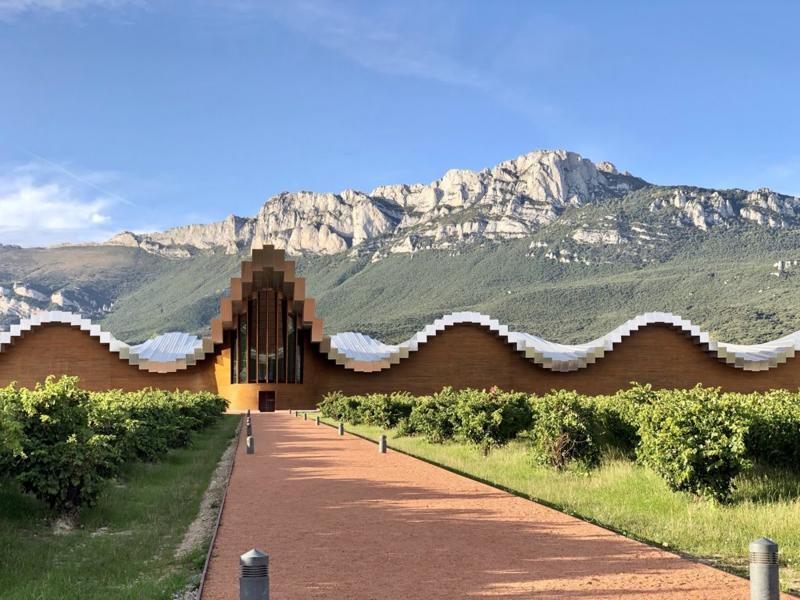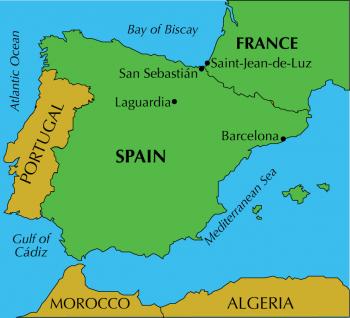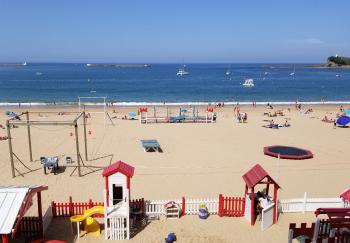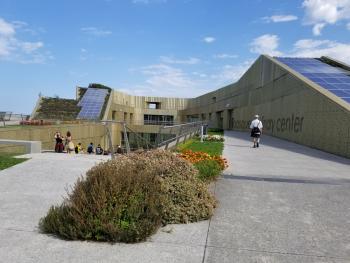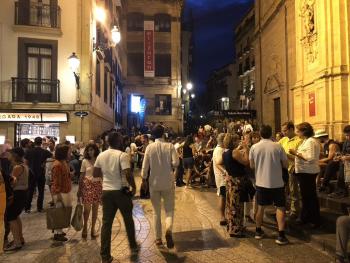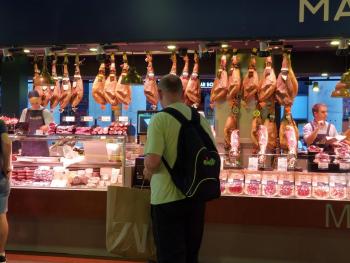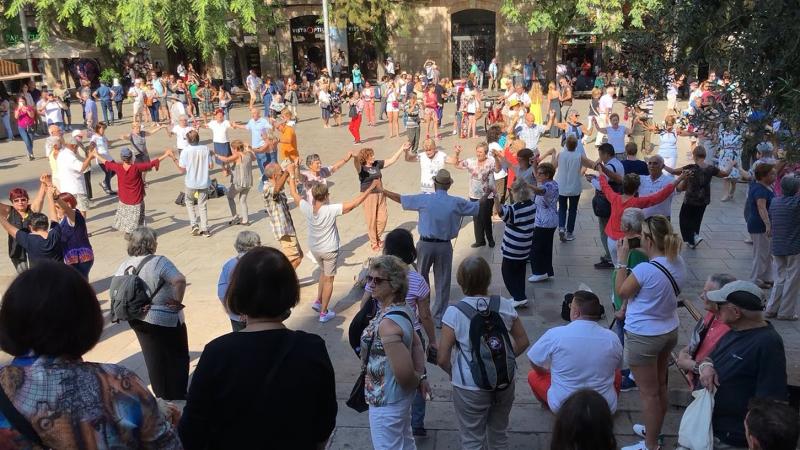Sharing Spain with friends on a visit to the Basque country
This article appears on page 6 of the January 2021 issue.
My husband, Michael, and I were headed back to Spain in early September 2019. This time, friends Jane and Paul (J&P) would be joining us for part of the trip. J&P had never been to Spain, so here are some of the things we did to make sure we all would still be friends when we returned.
Some ground rules
We planned to rent apartments in San Sebastián and Barcelona and reserve a hotel in Laguardia, so we asked J&P how they wanted to be involved with the accommodation decisions. They asked us to do the research and give them our final three choices to discuss and decide on. That worked very well.
We all agreed that we would not be joined at the hip, allowing us to go off in different directions. This was especially important because it was the fourth trip to Spain for Michael and me and we had already visited some of the sites that J&P wanted to see.
They tend to be spontaneous travelers, letting things just happen, but I knew that some things needed to be arranged in advance. When I found interesting events — like a concert at the Palau de la Música Catalana — and saw that we needed to get advance tickets, I got their permission to do so.
J&P could only be gone for three weeks, so Michael and I decided to go early and stay after for a few days, extending our trip to five weeks.
Bottom line — we left as good friends and returned home even better friends.
On our way!
Basque Spain and France awaited us. We flew into Hondarribia, where San Sebastián’s very small airport is located. There was a large welcoming sign extolling the virtues of the exceptional food of the area, which we’d soon find to be very true as we spent our time exploring its culinary offerings while awaiting our friends’ arrival.
A short taxi ride took us to Hotel Río Bidasoa (hotelriobidasoa.com), where we had planned to stay for two nights ($327 total) before going on to Saint-Jean-de-Luz, France. The hotel was nice and an easy walk away from the pedestrian area of the new town.
The central plaza had many restaurants, most with outdoor seating. We chose Yola Berri (San Pedro, 22) for some good pintxos (small snacks) and vino blanco.
After exploring the upper Old Town the next day, we returned to our hotel, excited about the new-to-us French Basque country that was up next on our itinerary. Having done our research, we’d chosen Saint-Jean-de-Luz as our base, and we could see it just across the bay.
Saint-Jean-de-Luz
In the morning, the helpful hotel staff called a taxi for the 35-minute ride (€45, or $54). The driver had a bit of difficulty finding Hôtel de la Plage (hoteldelaplage.com), which was literally at the beach, but finally we had success. Our room on the second floor overlooked the beach and had French doors that opened to it. (We paid $473 for four nights.)
Everyone at the hotel was very helpful. Laurent, at reception, gave us a list of restaurants and, as the next day would be a busy-restaurant Sunday, even made a lunch reservation for us.
One afternoon during our stay, I left Michael people-watching near the town’s church and went shopping on my own. Rue Gambetta, the main shopping street, had many lovely stores.
I had read about Chocolaterie Henriet, and as I began looking for the shop, I came across a small plaza where a man was playing oldies on an upright piano. As people passed by, they started humming; a few even performed some dance steps as they moved along.
And then there it was. Glorious chocolate! Treating myself, I enjoyed two samples in addition to making a purchase.
The next morning, we sat at Le Beau Marché, a café across from Les Halles market, and woke ourselves up with chocolate croissants, freshly squeezed orange juice (€5!) and a cappuccino and a latte. The market was very busy on that Sunday morning, and, of course, we had to take a walk-through to see the many mouthwatering goodies for sale.
Meals to remember
That evening, we again found ourselves near the market for a bite to eat. Dinner on the patio of Buvette de la Halle, a busy restaurant with old metal tables and chairs and simple, fresh food, proved to be one of our most pleasant evenings.
The best part was when the gentlemen sitting next to us, who helped the non-English-speaking waitress understand our requests, asked us where we were from. We spent the rest of the evening chatting with Oliver, Orlando and Oliver’s father, Peter. The men, who were from New York and traveled to Spain several times a year on business, shared some of their travel tips and experiences. It was one of those rare wonderful evenings that travel sometimes brings.
On Tuesday, I woke up early and went out for coffee, walking to Les Halles. I forgot that it was farmers’ market day, so there were many stalls outside, in addition to all the indoor vendors selling fresh produce and cooking huge pans of paella and sausages.
It was a mob scene with packed walkways. I stood in a long line at a nearby bakery to get some pastry to take back to our room.
We had read wonderful things about Chez Mattin (63, rue Evariste Baignol) in Ciboure, so we asked Laurent to make a lunch reservation for us. He confirmed our reservation for later that afternoon, and I was thrilled.
It was an easy walk across the bridge to Ciboure, where we found the restaurant in a residential area. Céline Niquet, chef Michel’s wife, presided over the restaurant, seating guests in the authentically Basque, wood-raftered dining room, with traditional tableware and shiny copper pots plus a cow yoke hanging from the ceiling. She explained the menu and wines to us, and we made our choices.
We shared a starter of chanterelles in a brown sauce with a poached egg hidden in the middle, then Michael had a fabulous fish stew (served with six well-toasted bread rounds to soak up the delicious sauce), while I had a unique “carbonara”: filleted pieces of John Dory served over squid tentacle “tagliatelle” in a very light cream sauce.
The pièce de résistance was a dessert of small scoops of house-made lemon sorbet surrounded by crushed champagne ice.
It was one of the best meals we’ve had! The lovely atmosphere and, most of all, attentive Céline and Michel added to the pleasure. (Entrées range from €16 to €29.)
On to San Sebastián
Laurent had arranged for a car (€70) to take us the next morning to San Sebastián, where we would settle into our apartment to wait for our friends to arrive that evening. Going through San Sebastián, the traffic was terrible, and when we arrived at the Feel Free Vacation Rentals office to pick up our apartment keys, things took a bizarre turn.
After our easy check-in, our driver started to unload our things. We reminded him that, as soon as we had the keys, we would need to continue on to the apartment. He announced it would cost €20 more because, when the price had been negotiated, he thought there would be only one stop. The apartment was only four blocks away, but the driver insisted it would take too long and he would have to be paid.
Michael emphasized that we had specifically said, when the car was ordered, that we would have to get the keys first and then go to the apartment, but the driver did not believe us and began calling the hotel for confirmation. After several minutes of waiting for him to connect with Laurent, we told him to leave.
Michael went back into the rental office, explained what had occurred and asked them to call a taxi. They did — and they insisted on paying the fare!
We finally arrived at the apartment and got settled in. There was a little fruit stand and market across the street, and we bought enough food for dinner, waiting to eat until J&P arrived, exhausted, later that evening.
We were pleased to find that the apartment Allegra ($2,327 for six nights), in the Gros neighborhood, looked just like it did on the internet, bright and modern.
Feel Free Vacation Rentals (feelfreerentals.com) was wonderful to work with. They have a 24/7 number to call if there are any issues, and they were always quick to respond.
Exploring the city
Being film buffs, one of the main reasons we had chosen specific dates to be in San Sebastián was to attend part of the San Sebastián Film Festival (SSFF). On a previous visit, we stood in line in the rain watching celebrities with whom we were not familiar arrive on the red carpet to great cheers and applause. We’d always wanted to return.
The apartment was walking distance from the main venue, the Kursaal, so the next morning we went to see about getting tickets. We got the program listing and were told how to get advance tickets on the internet.
The SSFF is a very big event, and people attend from all over the world. On the first day tickets were available online, the system went down, so it was flooded with orders as soon as it was back up, and I was not able to get tickets for the films we wanted to see. (The alternative was to go to the venue early on the day a film we wanted to see would be shown to see if there were any available tickets. Jane and I took on that responsibility, and we eventually saw one film before we left.)
It was time to introduce J&P to the pintxo scene. Pintxos, in addition to tasting good, are often small works of art. Céline from Chez Mattin had recommended Gandarias (31 de Agosto Kalea; restaurantegandarias.com) to us, so we crossed the bridge into the Old Town to find the restaurant. Mostly seafood based, the pintxos were indeed gorgeous. Whether at lunch or in the evening, the lively and loud pintxos scene was so much fun!
While J&P went to Bilbao the next day, Michael and I decided to investigate San Sebastián’s markets. We began at Mercado San Martín, which is smaller than the main one, Bretxa. It offered a nice walk along Avenida de la Libertad, lined with lovely shops ranging from designer-expensive to affordable.
On Michael’s birthday, we took the ferry, from nearby Pasaia, across the bay to a wonderful UNESCO World Heritage Site, Albaola (albaola.com). There, an authentic replica of a full-size whaling ship is being built. (It is also a school for ship and model-ship building.) Visitors can sit and watch the ship being built, and the lower floor houses an excellent historical museum detailing the area’s whaling industry, with maps and ship replicas. It was well worth the visit (open Saturdays and Sundays, 10 a.m. to 2 p.m.; admission, €7 per adult).
To the wine country
After one final relaxing day in San Sebastián, we ordered a large taxi to take us — and all our collective baggage — to the car rental office in the morning, then we were off to Rioja.
The drive on the toll highway to Laguardia in Rioja Alavesa was quite easy. It’s a broad, beautiful part of Spain and was quite scenic.
When we arrived at Castillo el Collaldo (Paseo el Collado 1), Paul and I went to check in and find our rooms. The parking area was across the street from the hotel, which is built into a hill over several levels, so being able to walk stairs is required.
Our room (No. 4) was large, with antique furnishings, a big bed (with cherubs looking down from above), an elegant marble bathroom with tub and shower, and an en suite sitting room. J&P’s room (No. 2) had a king-sized bed and a sauna in the middle of the bedroom!
After unpacking, we walked the path along the city walls that leads through the lovely Old Town. At the south portico, we found a plaque noting that this had been a Jewish area prior to the Inquisition.
I could see why people say this is their favorite town in Rioja Alavesa. It was gorgeous, with spectacular views! This is wine country, so there are vineyards everywhere you look.
When Michael and I went out to find dinner, we discovered that dinner began later there than in San Sebastián; no restaurant started serving dinner until 8 or 9 p.m.
At the information office in the morning, it was made clear that reservations were required to tour a winery, so Paul emailed Bodega El Fabulista (bodegaelfabulista.com) to see if we could reserve a tour. We were fortunate to get one for that afternoon.
We were told that El Fabulista is one of only two underground wineries operating within the city walls. Monte was a darling and lively tour guide. Her English was good, and when it wasn’t, she was good humored and we all helped.
It was a great tour. It took 1½ hours and was delightfully informative and well worth it. (A guided tour with two wine tastings costs €8 per person. Other options, featuring additional wines and snacks, are available.)
After a rest, we went to explore the Church of Santa María de los Reyes (laguardia-alava.com). A huge tour group arrived ahead of us, but we did get in. Unfortunately, the explanations inside were all in Spanish. (A printed English version was available, but it was difficult to understand.)
The church is famous for the many carved and painted statues situated around and over the main altar that recount the story of Jesus’ birth. Mary is the most important figure, and the large painted wooden statue of her is the centerpiece. It’s hard to describe but quite beautiful.
Following the church tour, just before sunset, we took the 2-kilometer walk across the vineyards to see Bodegas Ysios (www.bodegasysios.com), designed by the architect Calatrava. It was a great walk at that time of day, and the views of Ysios as we grew nearer were spectacular. It is simply a breathtaking building, sitting in the shadow of a limestone mountain.
Visiting the Frank Gehry-designed hotel on the grounds of the Marqués de Riscal winery in Elciego was something we all wanted to do, but the only way to get into the hotel if you are not a guest is to have a reservation at one of its restaurants. We were lucky to get a lunch reservation at its smart-casual 1860 Tradición (hotel-marquesderiscal.com).
Arriving at Marqués de Riscal, we discovered a very tightly secured area. After parking in an outlying lot, we had to stop at the guards’ office to tell them of our lunch reservation, and only then did they show us the path to walk to the hotel. (The hotel is separate from the winery building, where visitors can take a tour and visit the gift shop.)
The hotel was spectacular, with its undulating pink and gold titanium ribboned facade. We walked into a very bare lobby (only an information desk there) and were directed to the elevator that would take us directly to the restaurant. Our table was on the beautiful terrace; it was so elegant, from the gorgeous, marbled green dishes, green water glasses and heavy, modern silver utensils to the views. Lunch was a splurge ($117 for two) but well worth it.
Typical of the uniqueness of all the dishes we enjoyed, our 4-spoon shared “French toast” dessert was sweet-cream ice cream tucked into a croissant covered in warm chocolate sauce, with a side dish of diced kiwi, pineapple and grapes. Espresso made for a perfect ending.
Barcelona
Catalonia was our next destination. Arriving in Barcelona, we found our rental apartment with minimal trouble. Then Paul went with Michael to return the car. Anyone who has been to Barcelona knows that a car is definitely not needed.
The Gran Via Classic apartment (Calle Bailen, 43) was a disappointment. We discovered that there was no dishwasher, and dishes of all sizes were simply piled up inside a cupboard. The dryer was out on the balcony and could only be reached by going through the small bedroom.
There was no dresser in the small bedroom, and the beds in that room were more like cots. Also, there were no wastebaskets!
We called the owner, Carlos, and requested that he bring a wastebasket, extra towels, a cutting board and several other necessities. When he delivered them, I asked him to show me how the dryer worked; it was clear he had never used it.
The four of us decided to make the best of it and figured out how to create some private spaces.
We have rented many apartments and know the questions to ask, but we’d not used Tripadvisor to book a rental before. I found the site hard to use, and it was difficult to get our questions answered. We’ve had much better results with Vrbo or renting through a local agency or directly with the owner.
By the time we got settled in the apartment, it was too late to try to walk to the El Born neighborhood to meet some friends for tapas, so we had the experience of trying to hail a cab.
In San Sebastián, we had to phone for a taxi. There was no street hailing. Barcelona was the opposite. You had to hail a green-lighted (vacant) taxi on the street or go to a taxi stand. Ultimately, we were successful, but traffic was terrible, and we ended up being late.
As we approached them, our friends told us they had to give up the table at Cal Pep, an old, established tapas bar that we had been looking forward to trying, because we were too late, but we found an outdoor table at a nearby restaurant that proved to be very good.
Tapas portion sizes were larger than the pintxos dishes we’d enjoyed earlier in the trip. Sharing lots of good food, laughs and wine, we had a great time, followed by a pleasant walk back to the apartment.
A sense of community
We awoke to a glorious Sunday and walked to the Cathedral to watch the sardana dancers. (The sardana, a traditional dance of Catalonia, is performed by a mix of men and women holding hands in a circle and making choreographed moves.) The band was playing when we arrived, and the circles were forming. At one point, there were five circles going.
Seeing strangers and friends (who threw their purses and things into the center of their circle) joining hands for the dance gave us a wonderful feeling of community.
Farther down the street, we stopped to watch a woman singing arias from “Carmen” while she seductively approached onlooking men, in keeping with the theme. She was dramatic and funny, and her voice was terrific.
On another side street, we stopped to listen to a lovely young woman playing classical music on her cello. It was a joyful walk on our way to visit El Call, the old Jewish neighborhood, and its synagogue. We ended our day, pleasantly tired, with a salad at the apartment and a stroll to get gelato.
The next morning we took a taxi to Bet Shalom (betshalom.cat) for the Rosh Hashanah service. Arriving at Sardenya 414, an apartment building with a closed metal door next to it, Michael asked several people in nearby shops if there really was a synagogue at that address, which was confirmed. Soon we saw a man open the steel door, so we rang the bell and were admitted.
The synagogue sanctuary had been set for about 50 people; 30 eventually attended. The woman leading the service introduced herself as Ramona, from Israel, now living in Argentina. She explained that she had been coming to this small progressive congregation twice a year for 10 years to lead holiday services on Rosh Hashanah and Passover.
After the 2-hour service, challah bread and honey cake were served, and we chatted with two young women from the US who were living and working in Spain. We were very glad to have been a part of this intimate service, with its familiar prayers and melodies.
That evening was also very special. We had tickets for a guitar and flamenco performance at the most glorious Modernist/naturalist concert hall, Palau de la Música Catalana (palaumusica.cat). As we made our way to our third-row, center seats, we loved watching J&P marvel at the venue.
The three guitarists and one percussionist were fantastic, from their classical tango and flamenco performances to their humor. The walk home on a lovely evening was the ending of a perfect way to begin the Jewish New Year.
More city sights
On earlier visits to Barcelona, we’d rented apartments in the Gràcia area. We like that neighborhood, as it is more residential than touristy, and we wanted to share it with J&P.
I’d made a lunch reservation at BlauBCN (Carrer de Londres, 89) so we could have a celebration lunch before J&P left the next morning. The restaurant is quite contemporary, done in black and walnut, and its menú de la semana (menu of the week), at €25 per person, was truly a bargain for a delicious meal.
We were glad that J&P’s introduction to Spain had been such a success.
Michael and I originally thought we would go to Girona for a couple of days after J&P left, but we decided to stay in Barcelona. Since the apartment had new tenants coming in, we found a hotel to move to, Hotel Astoria (hotelastoria-barcelona.com), also in the Eixample neighborhood but in a different section that was completely new to us.
Hotel Astoria was a very interesting place. It has a connection with the Catalan artist and writer Ricard Opisso, who worked as an assistant to Antoni Gaudí, was a friend of Picasso and was an illustrator who made drawings oriented to political satire.
The lobby had a large room filled with his art and letters. Even if you don’t stay at the hotel, it is worth a visit to see the Opisso collection.
Our room (€429 for two nights) was ready, so we dropped our bags there before walking to El Born. We wanted to go back to Cal Pep (www.calpep.com), since we’d not been able to have dinner there on our first night in the city. We sat at the bar, and all the good things we’d read about this restaurant were confirmed.
There is no menu. Behind the bar, Javier asked about our food preferences — seafood, of course — and then supervised as each of four different dishes were prepared for us (€75 for the two of us).
CaixaForum, an art gallery in the Montjuïc area, sounded very interesting, and we had never visited it, so we decided to explore. A taxi dropped us at Plaça d’Espanya and we found the CaixaForum a few blocks away.
While we were in the lobby figuring out on which floor to start, a group of teens began a spontaneous dance performance outside the large picture window, garnering our enthusiastic applause.
Following that joyful performance, we went to a wonderful special exhibit on the history of opera and its connection to politics. The headphones we were given responded to sensors in each room, allowing us to hear some of the opera music that was featured in that room.
One room had a film, projected on a large wall, of a Paris Opera performance of “The Marriage of Figaro.” That alone was worth the price of the ticket (€6 per person).
There was also a silent movie of old Barcelona filmed by the Lumière brothers that was very interesting and fun to watch.
On our way to the CaixaForum we’d passed through a very active street fair, so we walked back there, enticed by block after block of food stalls. There were tables to sit at, lots of people to watch and a stage in the middle of it all where recorded music was playing. We shared an ear of grilled corn with queso on a stick, a sausage and a grilled chicken skewer. The weather was cool and overcast — just perfect for the walk back to our hotel.
We had taken some online travel advice and booked a room at a hotel near the airport for the night before we were to leave. A taxi took us to the Sallés Hotel Ciutat del Prat (hotelciutatdelprat.com) in just a few minutes, and we settled into our very nice room.
With plenty of time, we took the hotel shuttle to the airport to get our VAT refund and find something to eat, but the latter was not to be; there was no place to get food. The VAT refund was easy, however, once we found the office.
We took the shuttle back to the hotel and had a light dinner in the hotel snack bar.
The next day we flew home. It had been the best of our four trips to Spain, and we can’t wait to go back for a fifth!

